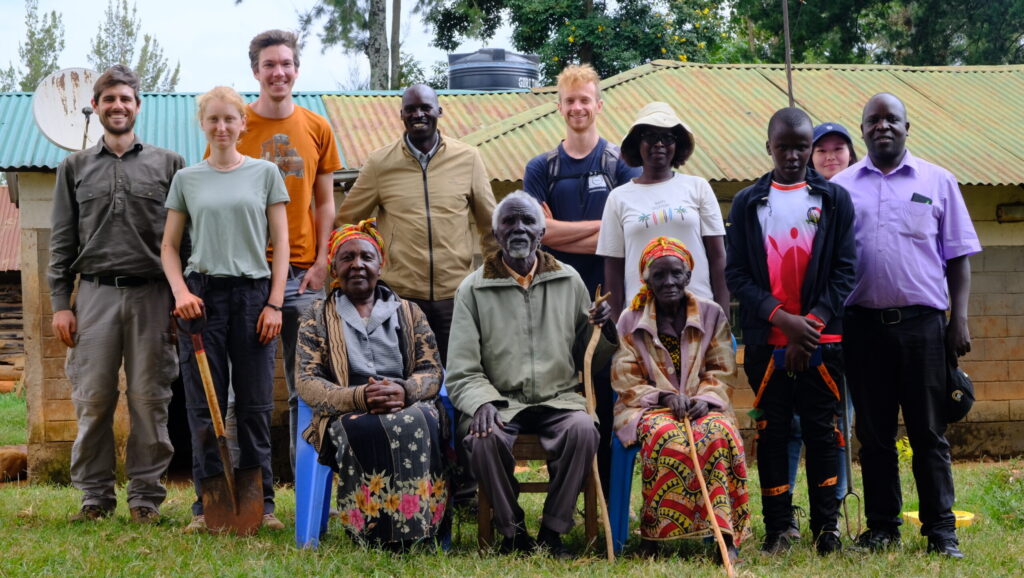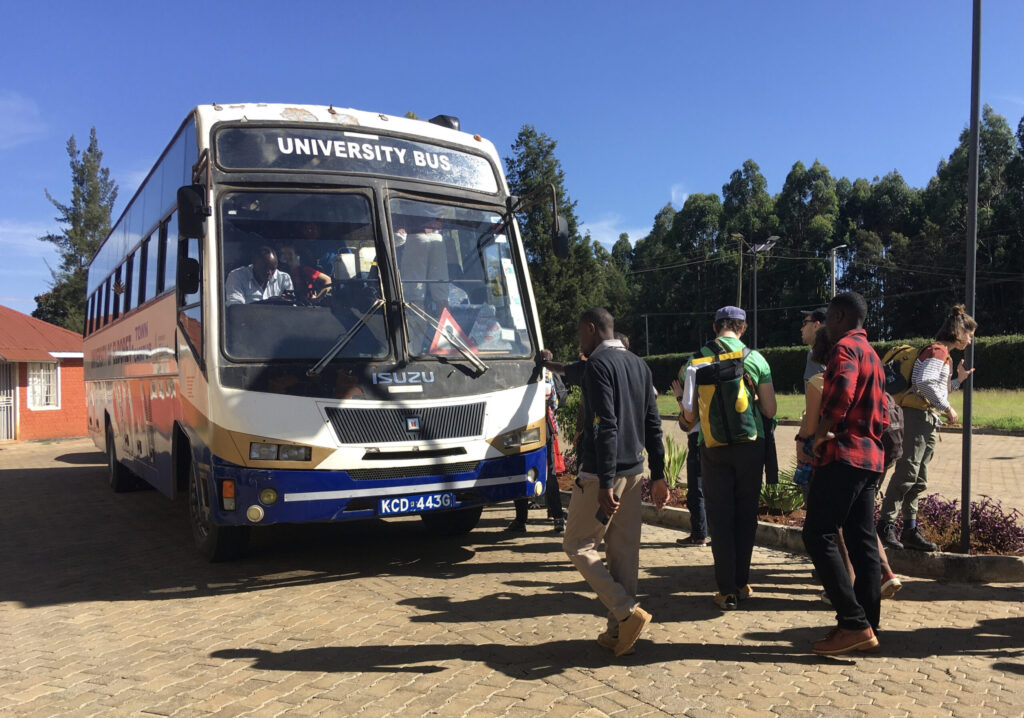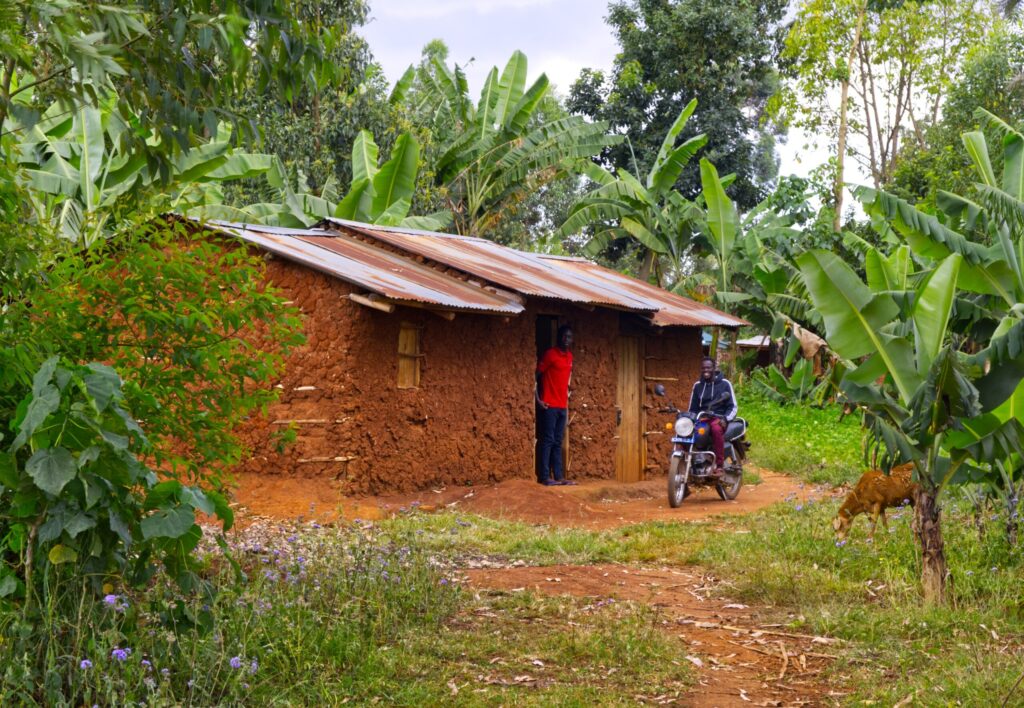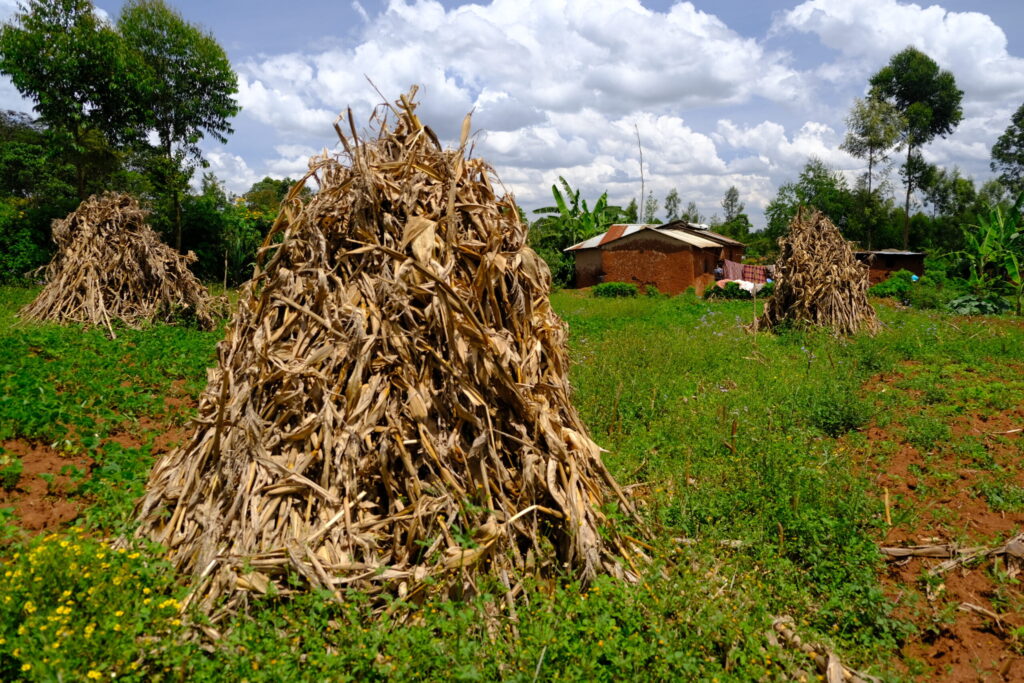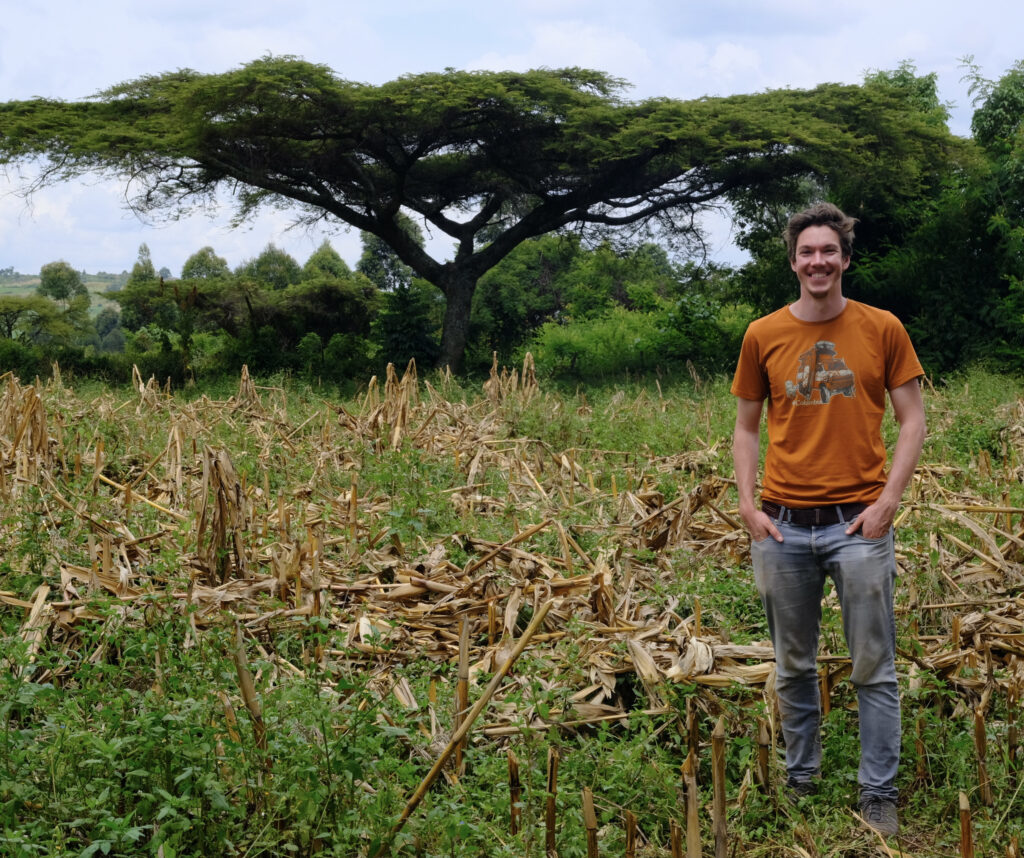Students in D-USYS have the opportunity to take part in one of the most exciting courses offered at ETH Zurich: Tropical Cropping Systems, Soils and Livelihoods. Every iteration of the course offers students a chance to gain first hand experience of agriculture in tropical Africa, examining the agricultural production system from soils and climate, to plant and animal science, food science, agricultural economics, on- and off-farm biodiversity and social sciences. This year’s course brought together 57 students from ETH Zurich, KU Leuven (Belgium) and University of Eldoret (Kenya) in a program that culminated in a 2-week field course to Kenya’s breadbasket in the highlands of the country’s west.
Agroecosystems & Resilience in Kenya: Reflections From a Field Course
Andrew Grigg & Arno Schneuwly, 22 December 2022
The students were split into 8 interdisciplinary teams, each with participating peers from all three universities. This year, students were asked to examine whether the local agroecosystem is resilient to climate change. After a series of preparatory workshops that trained us in a broad set of skills that could be applied in the field, the teams were given the opportunity to plan their own fieldwork in an assigned region, with the aim of answering the assignment question. Our team conducted this planning phase remotely over weekly Zoom meetings starting approximately one month before our departure to Kenya. The key challenge with meeting remotely was to find common time slots in the seven participants' packed time schedules. Once in Kenya, making time to meet was not an issue, as we were entirely immersed in the experience. All kinds of digital connectivity issues immediately dissolved.
Two weeks in Western Kenya
The study site this year was Trans Nzoia county. The region is located in the far west of Kenya, near the border of Uganda. Although it lies less than a degree from the equator, the region is situated on a large plateau at almost 2000 m altitude, and experiences a very mild climate. Each group was assigned a study area within the county, and ours was the village of Kiminini and the agricultural areas to its west. Kiminini is the second major population centre in Trans Nzoia County, after the capital Kitale, a hub for agricultural and market trading and an ideal place to get a sense of the local agricultural economy.
The study site this year was Trans Nzoia county. The region is located in the far west of Kenya, near the border of Uganda. Although it lies less than a degree from the equator, the region is situated on a large plateau at almost 2000 m altitude, and experiences a very mild climate. Each group was assigned a study area within the county, and ours was the village of Kiminini and the agricultural areas to its west. Kiminini is the second major population centre in Trans Nzoia County, after the capital Kitale, a hub for agricultural and market trading and an ideal place to get a sense of the local agricultural economy.
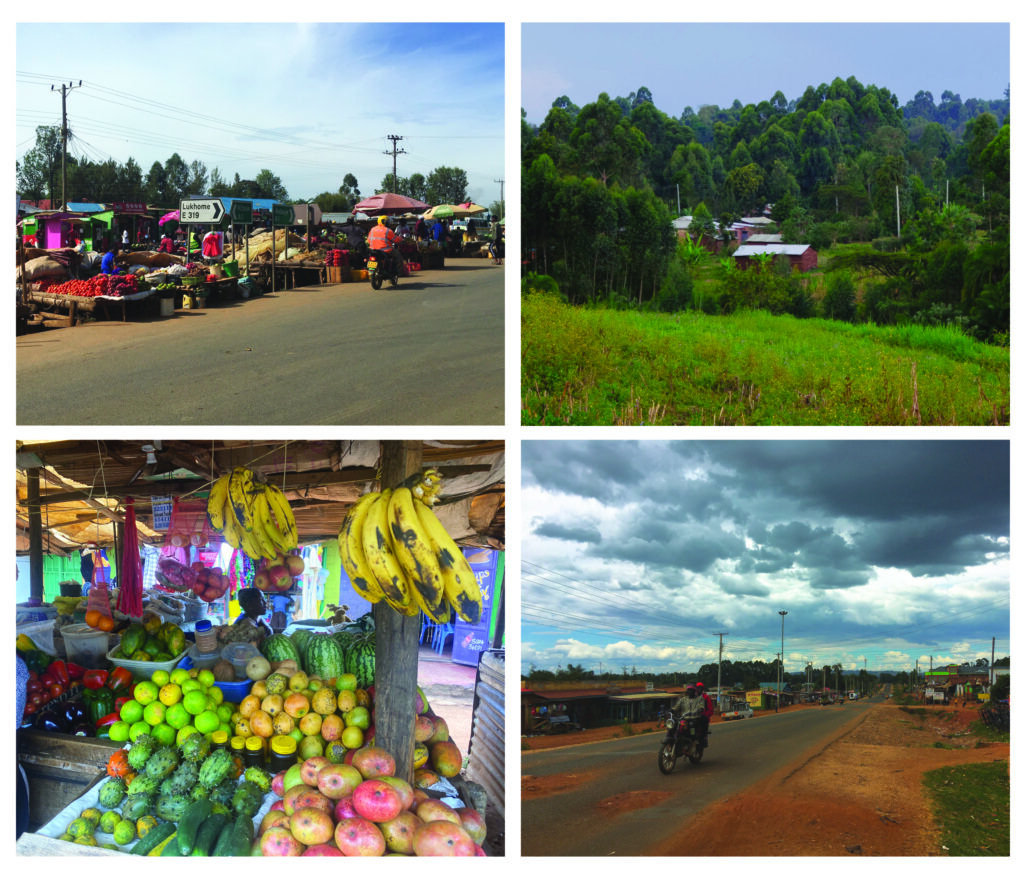
Impressions of Kimini and district. Top left: Markets at the intersection of the main roads in the village centre. Photo: Andrew Grigg. Top right: Mud houses in the fields near the village. Photo: Andrew Grigg. Bottom left: A stall at the central markets. Photo: Arno Schneuwly. Bottom right: A boda boda (motorbike taxi) on the main street of Kiminini. Photo: Andrew Grigg
During the field week, our group visited 19 farms over a range of 8 km, with the expressed aim of experiencing as much diversity as possible. Among the properties that we visited were a range of farm types, including subsistence holdings, family businesses and commercial enterprises, growing various food and cash crops, on a range of soil types. We benefited enormously from the time offered to us by the agricultural extension officer for the Kiminini ward, Namoi Mukusa, and learnt a lot through our discussions with local land holders, farmers, farm managers, agrochemical suppliers and market stall holders. The second week of the field course was dedicated to analyse, evaluate and formulate our results in a report. For this purpose University of Eldoret provided us facilities on their campus. That week was wrapped by presenting our findings to all course participants and staff.
Smallholder farms, agroecology and resilience
We noticed considerable heterogeneity in farm sizes and operating structures is a major difference from what we observe at home. On our farm visits we visited properties of just 0.2 acres, to large scale coffee, sugar cane and seed production properties of hundreds of acres each. We found that even large scale farms with access to substantial monetary funds do not operate with the degree of mechanisation we are used to in our cultivation areas.
Smallholder farms, agroecology and resilience
We noticed considerable heterogeneity in farm sizes and operating structures is a major difference from what we observe at home. On our farm visits we visited properties of just 0.2 acres, to large scale coffee, sugar cane and seed production properties of hundreds of acres each. We found that even large scale farms with access to substantial monetary funds do not operate with the degree of mechanisation we are used to in our cultivation areas.
One of the major concerns raised by many locals to whom we spoke was the rapidly rising cost of fertilisers. The turbulence on world markets heavily impacts the price of fertiliser and other inputs. With the productivity of the current cropping system so heavily reliant on regular inputs, many farmers have been left exposed to the whims of the market. The coming harvests are likely to demonstrate this instability, with the most devastating impacts for those who can least afford the price of fertilisers. This region is Kenya’s breadbasket, and the consequences of lower yields could be devastating for the region’s food security.
Another observable trend is the unpredictability of the seasons which raises difficulties for farmers to determine the ideal sowing times of their crops. Although the recent drought in East Africa, one of the most severe in recent memory, has not impacted the Trans Nzoia province as heavily as other regions of Kenya, changes in the quantity and timing of rain have been a challenge for locals. Despite farmers relying on boreholes to ensure a stable water supply, many reported sinking groundwater levels and water capacity difficulties. This is a problem on a regional scale and could, for example, be tackled by introducing a holistic water management scheme.
Another observable trend is the unpredictability of the seasons which raises difficulties for farmers to determine the ideal sowing times of their crops. Although the recent drought in East Africa, one of the most severe in recent memory, has not impacted the Trans Nzoia province as heavily as other regions of Kenya, changes in the quantity and timing of rain have been a challenge for locals. Despite farmers relying on boreholes to ensure a stable water supply, many reported sinking groundwater levels and water capacity difficulties. This is a problem on a regional scale and could, for example, be tackled by introducing a holistic water management scheme.
The effects of the recent drought has been a stress test for many agricultural producers in this region. While the long-term effects of climate change may look different from the effects of the recent acute drought, the event has nonetheless highlighted to many locals that they are exposed to climate shocks. Adaptive measures in response to climate change, including improved water infrastructure, plant breeding and crop diversification, are being implemented, but not universally. Farmers’ ability to adapt could, for example, be enhanced by expanding access to capital and reliable information.
A unique experience
The course was a rich and intense experience for all of the participants. We covered a range of scientific disciplines, worked in international, interdisciplinary teams for the duration of the course, and participated in a meaningful cultural exchange with local people. Countless unforgettable encounters with extremely kind families who warmly welcomed us at their homes, often without notice, graciously cooking delicious meals with their home-grown food, making their land and knowledge available to us, or even helping us to dig soil profiles. We were happy to be able to share knowledge to build a common understanding of current challenges and opportunities. Another memorable take-away are the introduction and goodbye rituals in formal and casual settings. Whenever we met a Kenyan official or family, all individuals introduced themselves formally and before leaving everyone present gave a short farewell speech. Hence, if many people were present these formalities might have appeared lengthy. However, in retroperspective, they gave each of us a moment to reflect on what we experienced and what mattered the most - something we could do more often in our daily lives.
A unique experience
The course was a rich and intense experience for all of the participants. We covered a range of scientific disciplines, worked in international, interdisciplinary teams for the duration of the course, and participated in a meaningful cultural exchange with local people. Countless unforgettable encounters with extremely kind families who warmly welcomed us at their homes, often without notice, graciously cooking delicious meals with their home-grown food, making their land and knowledge available to us, or even helping us to dig soil profiles. We were happy to be able to share knowledge to build a common understanding of current challenges and opportunities. Another memorable take-away are the introduction and goodbye rituals in formal and casual settings. Whenever we met a Kenyan official or family, all individuals introduced themselves formally and before leaving everyone present gave a short farewell speech. Hence, if many people were present these formalities might have appeared lengthy. However, in retroperspective, they gave each of us a moment to reflect on what we experienced and what mattered the most - something we could do more often in our daily lives.
In some way, this article is our farewell speech from Kenya. As such, we would like to take the opportunity to thank the hard work of Kenza Benabderrazik and Johan Six, in collaboration with a team from KU Leuven and the University of Eldoret, who make this course possible. Such a field course requires organisational effort beyond any regular course work planning, and we are sincerely grateful for the opportunity. All of us took home lifetime memories and learnings which go way beyond what one would absorb in any classroom. We would also like to thank our remaining team members Joan and Jacob from University of Eldoret, Emilia and Joris from KU Leuven and Jade from ETH Zurich for their commitment, hard work and good humour. We made connections and acquaintances across continental borders and some of us - the future will show - most likely also became friends for life.
About the Authors

Andrew Grigg
Andrew is a doctoral student in the Soil Chemistry group at ETH Zurich. His research focuses on iron mineral geochemistry in soils, in particular, the mineral transformations occurring in acid-sulphate soils in Thailand.

Arno Schneuwly
Arno is a MSc student in Agricultural Sciences at ETH Zurich. His key interests, apart from agriculture, are in Economics, Software and Artificial Intelligence. He loves outdoor sports such as hiking, alpine skiing or rowing.


